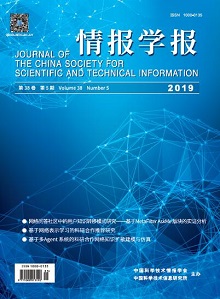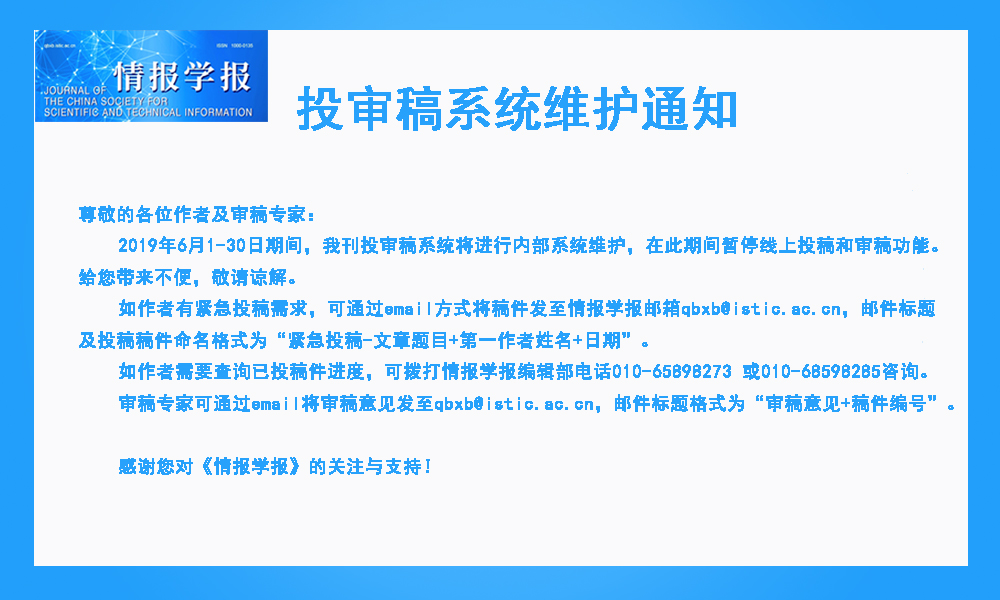 |
|
2019 Vol. 38, No. 5
Published: 2019-05-28 |
|
|
| |
|
|
|
|
|
447 |
Knowledge Transfer Model of a Network Q&A Community: An Empirical Analysis Based on the AskMe Portion of MetaFilter Data Hot! |
|
 |
Xia Lixin, Yang Jinqing, Ye Guanghui, Cheng Xiufeng |
|
|
DOI: 10.3772/j.issn.1000-0135.2019.05.001 |
|
|
To explore the influencing factors and mechanisms of user knowledge transfer in Q&A community networks, this study proposes a knowledge transfer model for Q&A communities by introducing social network analysis (SNA). This study first analyzes the interpersonal knowledge network structure of the MetaFilter Q&A community while considering net density, structural holes, central potential, average shortest path, and the clustering coefficient of SNA. The study then inspects the structures of the following four types of networks and their effects on knowledge transfer in the Q&A community: strong-and-sparse ties, weak and tight ties, strong and tight ties, and weak and sparse ties. The results of the study indicate the following. (1) Both strong-and-sparse and weak-and-tight ties networks contribute to knowledge transfer in a Q&A community. (2) When the restrictiveness of structural holes is lower and the network is sparser, users can more easily gain access to heterogeneity knowledge sources, and the average shortest path is shorter. In addition, the small-world effect is more obvious, and users can more effectively exchange knowledge. The clustering coefficient has a two-part effect in which it is neither higher nor lower. When it approximates the results of the entire network, it contributes to knowledge transfer. Furthermore, a higher central potential indicates that the relations of users are very close, and thus it has a greater influence on knowledge transfer. (3) Although the SNA index has a decisive role in knowledge transfer, some indices have a joint effect. An efficient network may still have several low indices. In summary, this study explores the influence of different network structures on knowledge transfer to enable network structures to be adjusted based on index coefficients, thereby improving the efficiency of knowledge transfer on Q&A communities. |
|
|
2019 Vol. 38 (5): 447-457
[Abstract]
(
339
)
HTML
(141 KB)
PDF
(2945 KB)
(
939
) |
|
|
|
482 |
Research on Construction of a Subject Knowledge Base based on Literature Knowledge Extraction: Using the Knowledge Base of Activating Blood Circulation and Removing Stasis as the Object Hot! |
|
 |
Ma Yumeng, Wang Fang, Huang Jinxia, Jiang Enbo, Zhang Xiyu |
|
|
DOI: 10.3772/j.issn.1000-0135.2019.05.004 |
|
|
Researchers put forward higher requirements for efficient acquisition and utilization of domain knowledge in the big data era. As literature is an effective way for researchers to quickly and accurately understand the research situation in their field, knowledge discovery based on literature has become a new research method. As a tool to organize and manage knowledge in a specific domain, the subject knowledge base can be used to mine and present the knowledge behind the literature to meet users’ personalized needs. This paper designs the construction route of the subject knowledge base for specific research problems. An information extraction method based on knowledge engineering is adopted. First, a subject knowledge model is built through abstraction of the research elements. Then, under the guidance of the knowledge model, the knowledge extraction strategy of each model node is developed to analyze, extract, and correlate entities, relations, and attributes in the literature. Finally, a database platform based on this structured knowledge is developed that can provide a variety of services such as knowledge retrieval, knowledge browsing, knowledge Q&A, and visualization correlation. Taking construction practices in the field of activating blood circulation and removing stasis as an example, this paper analyzes how to construct a subject knowledge base based on literature knowledge extraction. As the system functional test shows, this subject knowledge base can realize the expected service scenarios such as quick query of knowledge, related discovery of knowledge and literature, and knowledge organization. As this study proposes an effective technical route to building a subject knowledge base to help researchers locate and acquire deep knowledge in literature quickly and accurately, it provides a transformation mode of resource construction and personalized precision services in the data-intensive research environment. |
|
|
2019 Vol. 38 (5): 482-491
[Abstract]
(
290
)
HTML
(96 KB)
PDF
(2247 KB)
(
1234
) |
|
|
|
492 |
Research on Crisis Detection in Infectious Disease Surveillance Data Hot! |
|
 |
Wang Ping, Mu Dongmei, Gao Hexuan, Fa Hui |
|
|
DOI: 10.3772/j.issn.1000-0135.2019.05.005 |
|
|
As China s informatization process continues to accelerate, infectious disease surveillance systems have accumulated large amounts of accurate data. According to the theories and methods of information science, we can fully mine the intelligence value of information from infectious disease surveillance data. Analysis of this material can provide decision support services for public health management and prevention departments. In particular, this study focused on data from the China Statistical Yearbook of Infectious Diseases, and the China National Bureau Statistics monthly report on infectious disease prevention and control. The process of monitoring and identifying infectious disease crisis events is summarized as “one goal, three objects, three levels of analysis, and three cores.” Another aspect of infectious disease control is building crisis detection/decision support service systems. Theoretical level, this study assesses data integration, information analysis, and crisis detection in infectious disease events. On a practical level, it integrates methods of statistical information analysis with machine learning to establish a forecasting model of epidemic over time. Its aim is promoting theoretical research and practical innovation related to the monitoring, identification, and crisis detection of infectious diseases. |
|
|
2019 Vol. 38 (5): 492-499
[Abstract]
(
227
)
HTML
(98 KB)
PDF
(2474 KB)
(
692
) |
|
|
|
500 |
Scientific Collaboration Recommendation Based on Network Embedding Hot! |
|
 |
Yu Chuanming, Lin Aochen, Zhong Yunci, An Lu |
|
|
DOI: 10.3772/j.issn.1000-0135.2019.05.006 |
|
|
This paper researched a scientific collaboration recommendation model in the financial field based on network embedding to promote the formation of a research team in the same research field and improve the efficiency of research. The model integrates two types of network embedding models; one of these is based on the location of vertices, while the other is integrated with network structure. A binary operator for the representation of two vertices was employed to generate a representation of edge. Combining network embedding and machine learning, the model trained a logic regression classifier with the representation of edges as features, and the labels acquired from the classifier were the results of link prediction. By analyzing papers in the financial and physical research fields, several scientific collaboration networks were constructed. The experiments confirm that the proposed integrated model has achieved better performance than single models on the value of AUC, with the efficiency improved by up to 2%; even on a small training set, the value of AUC still reached 60%. The proposed model proved to be feasible in scientific collaboration recommendation, which will effectively promote the formation of a research team in the same field. |
|
|
2019 Vol. 38 (5): 500-511
[Abstract]
(
450
)
HTML
(150 KB)
PDF
(1081 KB)
(
1157
) |
|
|
|
512 |
Modeling and Simulation of Knowledge Diffusion in Scientific Collaboration Network Based on a Multi-agent System Hot! |
|
 |
Guan Peng, Wang Yuefen, Fu Zhu |
|
|
DOI: 10.3772/j.issn.1000-0135.2019.05.007 |
|
|
It has been proposed that knowledge diffusion in scientific research cooperation networks is affected mainly by knowledge spillover and knowledge innovation. On the basis of this idea, this paper proposes a knowledge diffusion mechanism. This multi-agent system modeling method is used to build a simulation evolution model of knowledge diffusion in scientific research cooperative networks. Thereafter, the influence of network structures, knowledge overflow effects, and individual knowledge innovation ability on knowledge diffusion is analyzed. Through a comparative analysis of evaluation indexes of the knowledge diffusion effect, the following conclusions are drawn. The topology of scientific research cooperation networks has an impact on the knowledge diffusion effect, and a BA scale-free network structure is superior to other network structures (regular network, small world network, random network). The knowledge spillover effect affects mainly the early stage of knowledge diffusion. With the increase in the knowledge spillover efficiency factor, the average network knowledge stock increases in oscillations, the knowledge diffusion rate increases, and the balance degree of network knowledge stock distribution decreases. Individual knowledge innovation ability affects mainly the later stage of knowledge diffusion. Networks with large individual knowledge innovation ability factors show strong average knowledge stock growth, which also aggravates the unbalanced distribution of knowledge stock among individuals. |
|
|
2019 Vol. 38 (5): 512-524
[Abstract]
(
345
)
HTML
(143 KB)
PDF
(2594 KB)
(
774
) |
|
|
|


